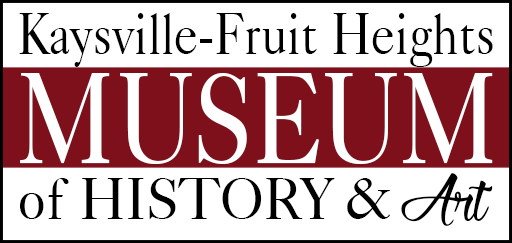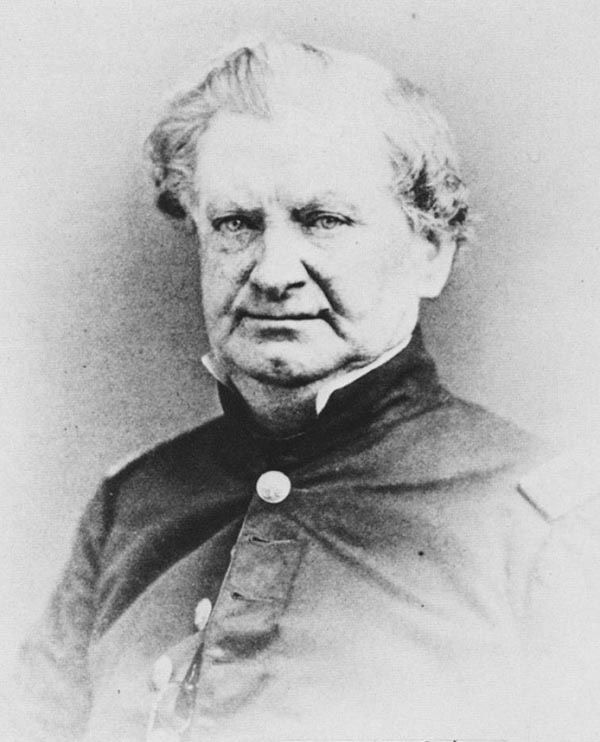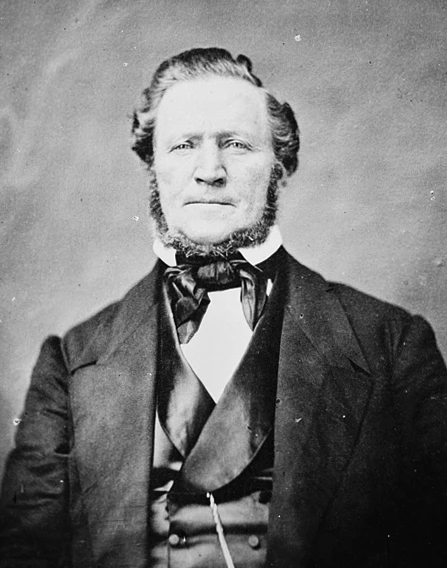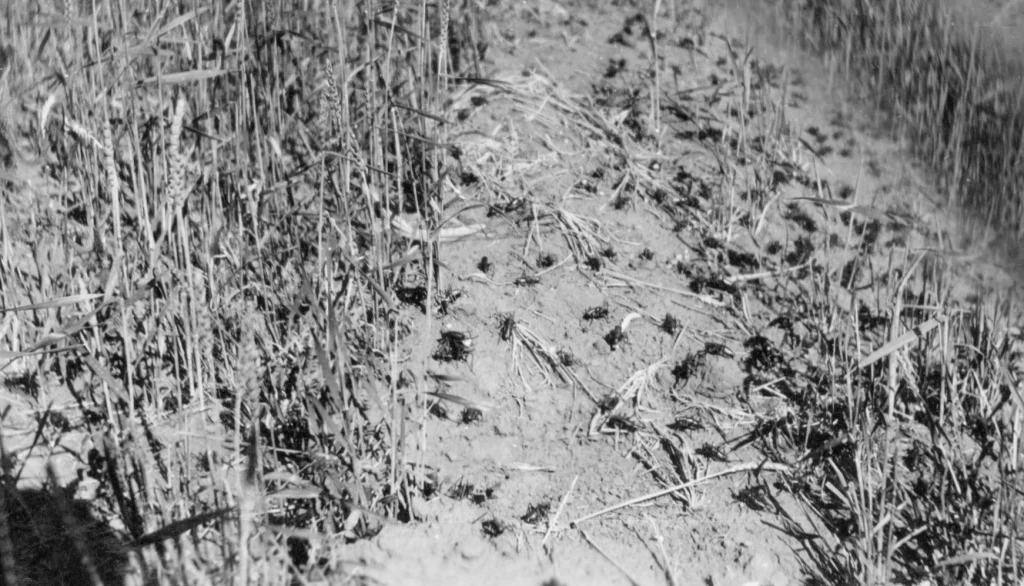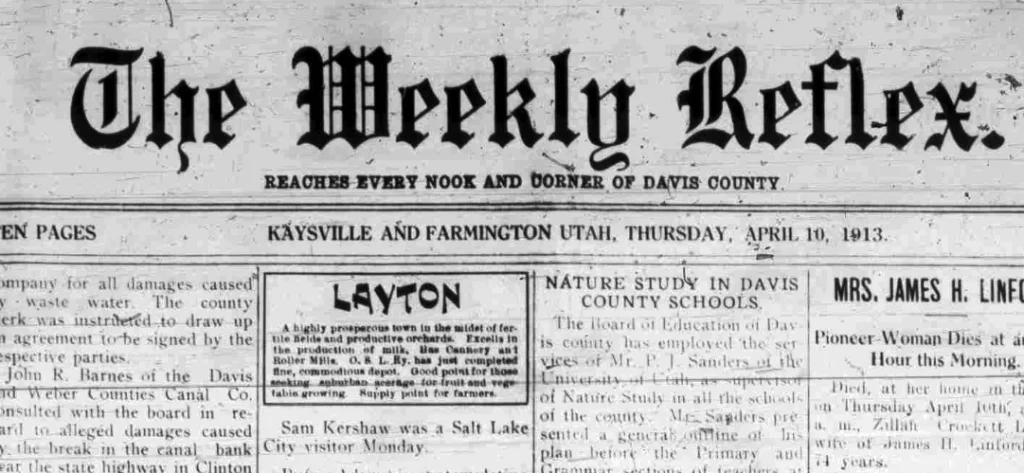Our History
PRESERVING THE PAST FOR THE FUTURE
A Brief History Of Kaysville
Carl L. Becker, an American historian, wrote that history, “Prepares us to live more humanely in the present and to meet rather than to foretell the future.” Treating one another well in the present is a worthy pursuit and if understanding the past can help us do it well it is worth trying to understand where we came from. This might include family history, world history, or the history of the places we find ourselves in. The Kaysville – Fruit Heights Museum of History & Art invites you to learn about the place that has been part of our collective story, past and present.
Early Times
Shoshone peoples traveled through the area that is now Kaysville for centuries before the white man arrived. A nomadic people, they seasonally spent time here as they gathered herbs, seeds, and berries. They camped along the local streams, ground their meal, and hunted game, giving thanks for the blessings of the land. Occasionally, they buried their dead under the rocks of scree slopes along the mountain benchland, and sometimes left petroglyph markings for others to read.
First Recorded Visit
Jim Bridger descended the Bear River in a bull-boat.
He circumnavigated the Great Salt Lake, likely passing by the area later to be known as west Kaysville.

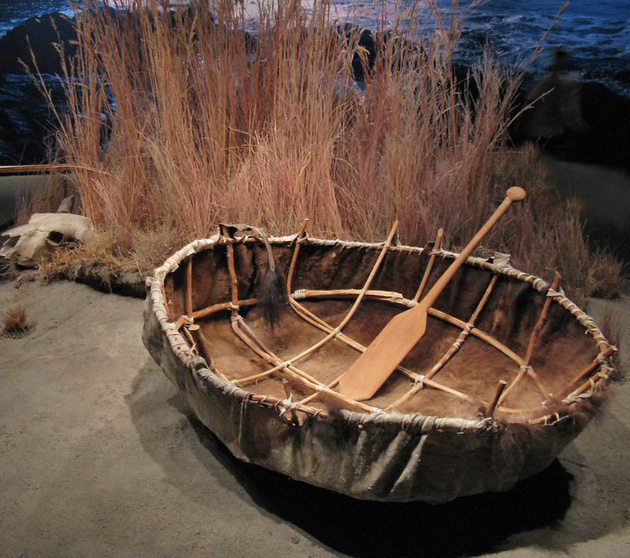
Early Emigrants
“Several white trappers, small exploration parties, and a few early emigrant wagon trains passed through the valley between 1843 and 1847. The Edwin Bryant Company traveled down what came to be known as Weber Canyon and passed through Davis County along the eastern benches of the mountains. The group stopped for a brief time just east of Kaysville and according to the party’s historian, the Wasatch Mountains were in flames.” A wildfire, driven by winds blazed “with great fury all night.” (Sanders)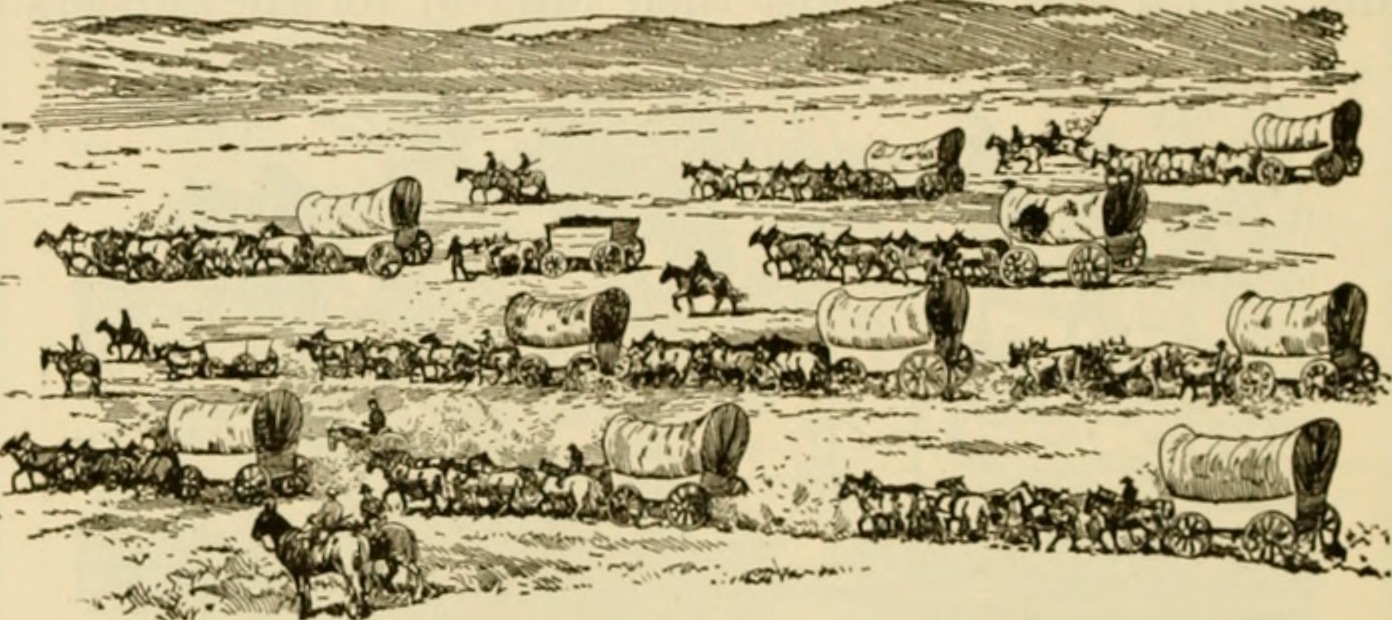
First Settler - Hector C. Haight
Two months after Brigham Young arrived, a company, Hector Caleb Haight, farmer and stock raiser, and his family of seven arrived in the Salt Lake Valley with the Daniel Spencer Hundred Company. Hector volunteered to care for part of the community cattle and traveled north with his son, William. They settled near a creek that would later bear his name, Haight’s Creek. His story shows that the first person in the settlement to perform an act of unselfish service was its first settler, Hector C. Haight. Read More…
Holmes Creek Origin
In 1848, Samuel Oliver Holmes, the second settler, and his family of six settled at the confluence of two streams now called Holmes Creek. He stayed only a short time before moving to California, but long enough to permanently affect the future of the settlement. [One resource states that Holmes took up residence initially in an existing hut thought to have belonged to fur trappers. Read More…
Snow Drifts & Two Englishmen
In the fall of 1849, two Englishmen, John Green and Edward Phillips, traveled north from Salt Lake City to Brown’s Fort, which is now Ogden, to find a place to settle. In the area of “The Sand-Ridge”, where Hill Air Force Base is now located, they were caught in heavy snow drifts and forced to turn back. They found refuge in Holmes’ cabin. That night, Phillips and Green decided to settle in this area rather than Brown’s Fort.
English Settler Influence
On or about April 10, 1850, Edward (and presumably John who was his son-in-law) started with their families to settle on Sandy Creek which was later called Kay’s Creek. They arrived, according to Edward’s account, one day previous to William Kay. The influence of these men on the future of the community is immeasurable because many other English settlers followed them. Nineteen of the first 29 families who came to this little settlement were English.
Early Davis County Boundary
Howard Stansbury completed a survey and map whereby Davis County was identified. The county was created by an act of the legislature of the “State of Deseret”. Thus, the outer geographical boundaries of the settlement were established and extended from Haight’s Creek on the south to the Weber River on the north. The areas now occupied by the towns of Fruit Heights, Layton, Syracuse, Clearfield, West Point, Clinton, Sunset, Hill Air Force Base and South Weber.
First Priority - Survival
A large number of families settled in the community during the first few years following. The land was unclaimed, or so they thought, so each family selected a plot and began the task of building a home. Some exhibited the pioneer spirit by helping others lay out plots of ground. William Blood discovered shelters already built by native Shoshone peoples on the land he claimed.
As the people began to till the ground, they learned many lessons. After experimentation, it was determined what type of crops could be grown. For instance, Reddin Allred planted cotton and discovered that the growing season was too short for a profitable cotton harvest. Food supplies of the new settlers were often insufficient to survive their first winter. Crops were hurriedly planted using crude hand-made implements as farm tools. Food was gathered from natural sources, and people shared with each other so nobody starved.
Survival was a first priority. The most pressing needs were to obtain shelter, food and water before the coming winter. Dirt dugouts and wagon box were some of the earliest homes. Cabin building was somewhat improved by Robert W. Burton and John Marriott who constructed a saw-pit near William B. Smith’s Cabin. Many families such as the Rushforths shared the living space of small one-room dwellings.
Water was crucial to the survival of families, their animals and their crops. Those on Kay’s Creek, for example, worked together to construct the necessary ditches to convey the water from the creek to their several claims. Everyone did his share of the work in proportion to the amount of land to be irrigated. According to Joseph Barton, “It was the same with all the original water claims; a general understanding and agreement to work together.”
Brigham Young Visit
Brigham Young and Heber C. Kimball, presiding leaders of the Church of Jesus Christ of Latter-Day Saints, visited the cabin of Edward Phillips and organized Kay’s Ward. Kay, Phillips and Green were named as presiding ward leaders. The first church meetings were held in Edward Phillips’ cabin. Since all the people living in this area in the earliest days were members of the same church faith, the community functioned as a theocracy.
First School
The first school in Kay’s Ward was conducted by Robert Knell in 1851. Classes took place in a small log house near Edward Phillips’ cabin. Two years later, John R. Barnes taught in the same building.
Population 417
A large influx of settlers came to the area in the decade between 1850 and 1860. By 1853, the population was listed as 417 persons.
Fort Construction
William J. Barnes, his brother John R. Barnes, William B. Smith, John Marriott began digging to build a fort wall. Brigham Young had advised the pioneers to build forts as protection from natives. Jesse W. Fox, Church Surveyor, was called in to layout the location. The plan was to dig a mote around the outside of the fort, and use the clay from the diggings to make adobes for the wall. The fort was never completed because the people of Kay’s Ward never had a serious problem with the indigenous people of the area.
Cricket Infestation
Emily Stewart witnessed a cricket infestation in 1855 which she later recorded. “The grasshoppers came and devoured nearly all the wheat, and as a result food was so scarce that we all lived on weeds and roots and many nearly starved to death.” The sky became very dark. When they looked up, all that was visible was “one solid mass of grasshoppers moving toward our crops.” The insects attacked the community in other years of 1856, 1867, 1868, and 1870, but never would they totally cripple the community as they did in 1855.
Hard Winter
“In 1856, we had what they called The Hard Winter. It was so cold with lots of snow and wind that we were constrained to turn cattle out on the range to gather what food they could. … At night we could … The water in the mill streams throughout northern Utah froze. Weinel Mill was spring fed and was one of the few if not the only stream that did not freeze. Settlers from as far as Bear Lake made a three-week journey to secure milled flour.
First Grist Mill
First modern grist mill in operation
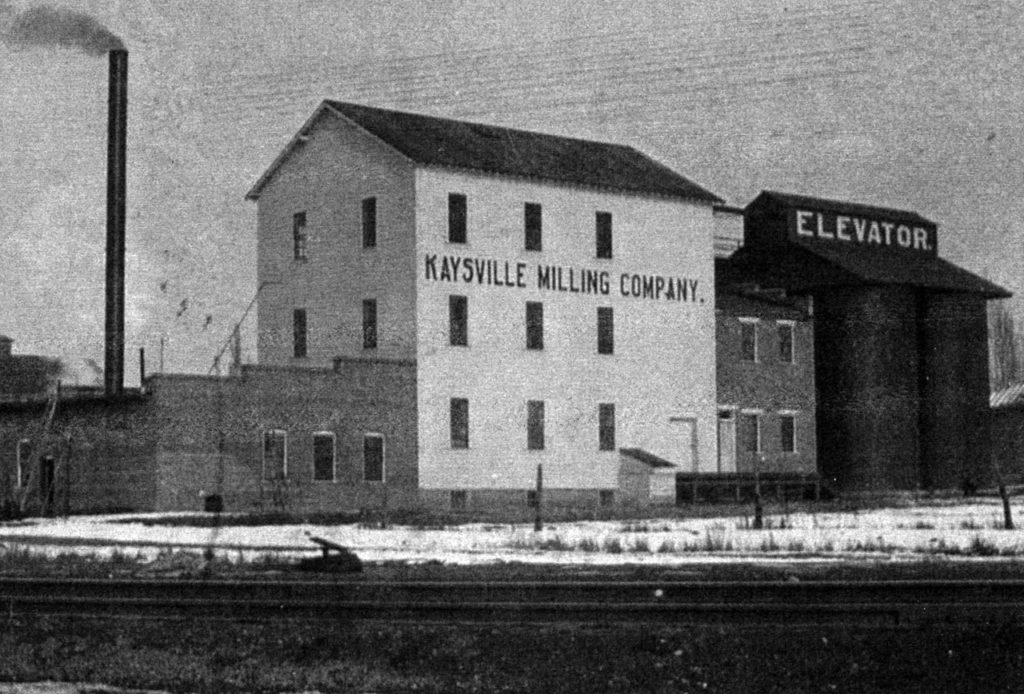
First City in Davis County
Kaysville became the first incorporated city in Davis County and 23rd in the state.
Source: Utah State Archives
Transcontinental Railroad
The transcontinental railroad “Golden Spike” event.
Men of the Kaysville Brass Band serenaded the train as the tracks were laid down Weber Canyon. At the mouth of the canyon, they were invited onboard and were the first to ride into the greater Salt Lake/Ogden Valley on its way to Promontory.

KCMI Established
The Kaysville Cooperative Mercantile Institution (KCMI) was established.

Music Hall Constructed
In 1875, the Kaysville Music Hall was built. Located at the corner of 100 E 100 N, just north of Kaysville Elementary. It burned down in 1910. This is the only known photo of the music hall.

Brick Kiln Built
In about 1875 or 1876, Samuel Ward built a set of kilns on his Mountain Road property. For over forty years, Samuel and his son Robert supplied bricks for the building boom that swept through Davis County. Many large Victorian homes were built between 1870 and 1900 and most of the brick used in the construction of these homes came from the Ward’s. One of the signature adobe brick colors produced was a bright red which became a standard and from which much of Kaysville was built in the earliest days. This was the first manufacturing business to produce brick in Kaysville and areas north within Davis County. Drawing of Samuel Ward, owner and operator of the Ward Brickyard
Drawing of Samuel Ward, owner and operator of the Ward Brickyard
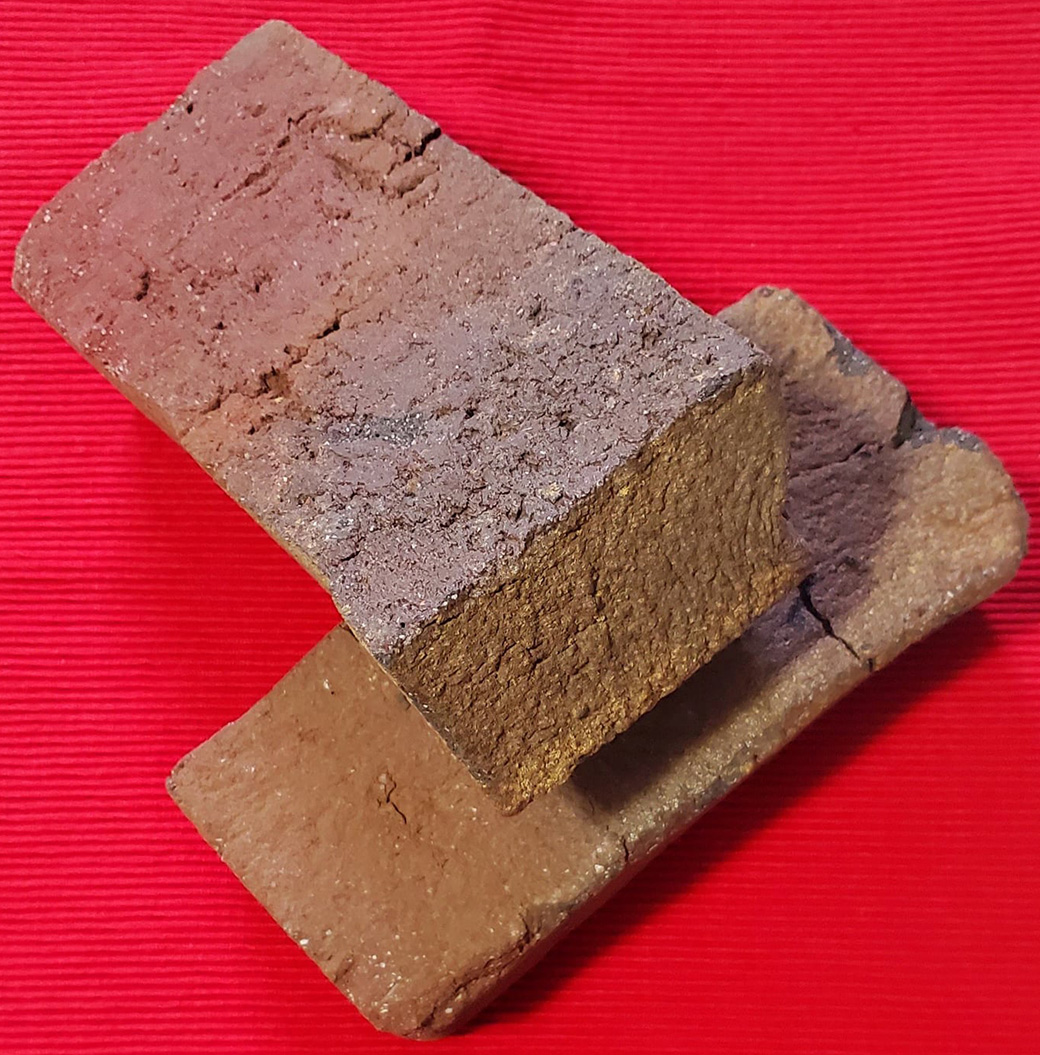 Bricks unearthed by Samuel Ward’s great, great grandson Jason Ward and wife Lisa, in their orchard near to the location of the brickyard
Bricks unearthed by Samuel Ward’s great, great grandson Jason Ward and wife Lisa, in their orchard near to the location of the brickyard
Williams Corner Business
In 1876, Ebenezer Williams built a store on the corner… and began his business
Silk Industry
One of the most unique enterprises of pioneer days was the silk industry. At a meeting of the Kaysville Relief Society in 1876, Eliza R. Snow advised the ladies to raise silkworms. Mrs. Louisa Egbert was a leader in the work and did a great deal of reeling and spinning in the west room of her hotel.

Egbert Hotel. Louisa Egbert in upper right inset.
Brigham Young's Death
In the midst of plural marriage becoming a hot political issue, Brigham Young died. His death catapulted a controversy resulting in the Edmunds Act of 1882 and the Edmunds Tucker Act of 1887 which established specific punishments for the continued practice of plural marriage. In the years that followed, several men from Kaysville were arrested and sent to prison. President John Taylor went into hiding at the Thomas Roueche residence and died in west Kaysville on July 25, 1887.
Presbyterian Church Built
The Haines Memorial Presbyterian Church was constructed in 1879 at 100 E Center St.

First Residence Telephone
In 1883, the first residence telephone was installed in the home of John R. Barnes.

Brick & Tile Manufacturing
The Kaysville Brick and Tile Manufacturing Company formed and a manufacturing yard was set up near a substantial clay deposit on Cherry Street.
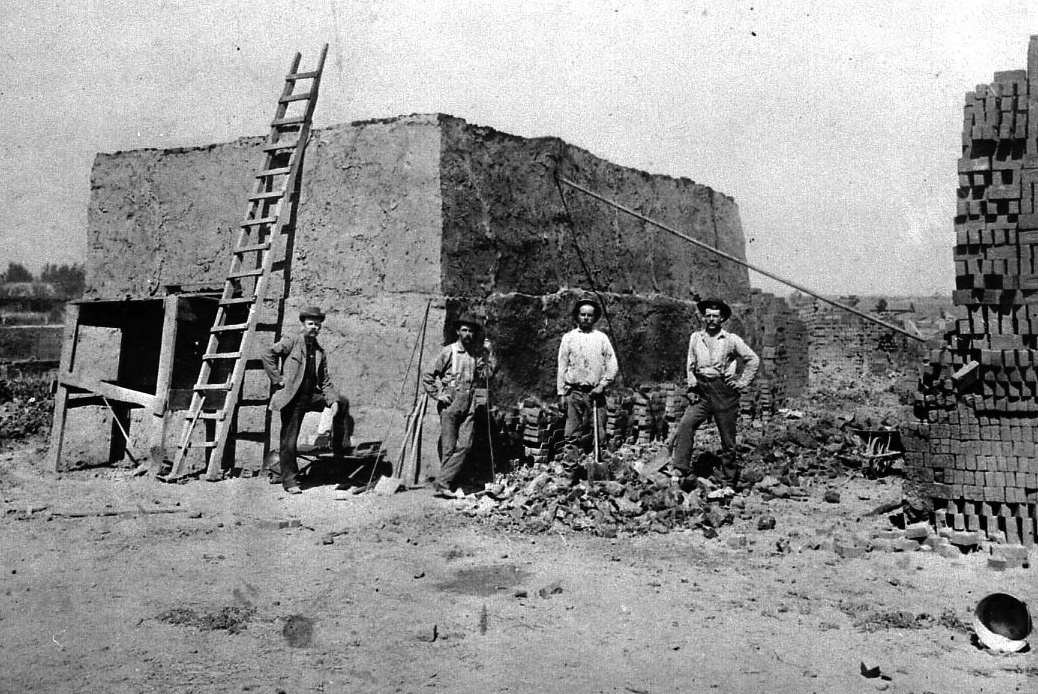
Barnes Bank
In 1891, Barnes Bank opened on the corner of Main Street and Locust (Center) Street. It was successful from the start, including the difficult depression years.

Sheffield Mercantile
Heber J. Sheffield opened a mercantile and hardware store in the middle of the Old Town business block in 1892.
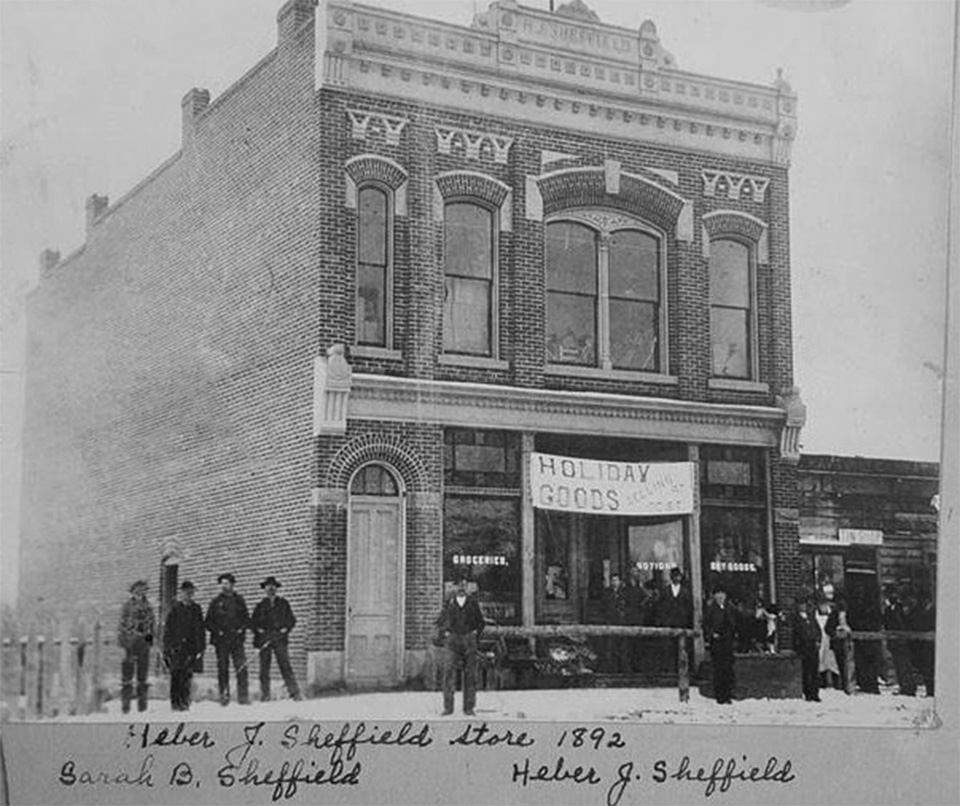
Woman's Suffrage
Ellen Ann Beazer Barton attended the Davis County Convention of the Woman’s Suffrage Association in October of 1893. Sarah Barnes Layton, Ada Evans Williams, Sarah H Blamires Sheffield, and other female activists of Kaysville actively supported the suffrage cause, during the 1890s.
Ellen Ann Beazer Barton
Utah Becomes 45th State
Finally, in January of 1896 after demonstrating compliance to the Manifesto and laws governing marriage, Utah became the 45th state of the United States of America. The people of Kaysville celebrated along with the rest of the state.

Canning Tomatoes
A group of local Kaysville men met in the Kaysville LDS meetinghouse to discuss the possibility of starting a canning company. Tomatoes were to be the main crop for canning purposes.

Bamberger Railroad
The Bamberger Railroad was built and operated from 1892 to 1958. Service through Kaysville began in 1906. It was built by Simon Bamberger, a famous Utah businessman and the fourth Governor of Utah (1917-1921).
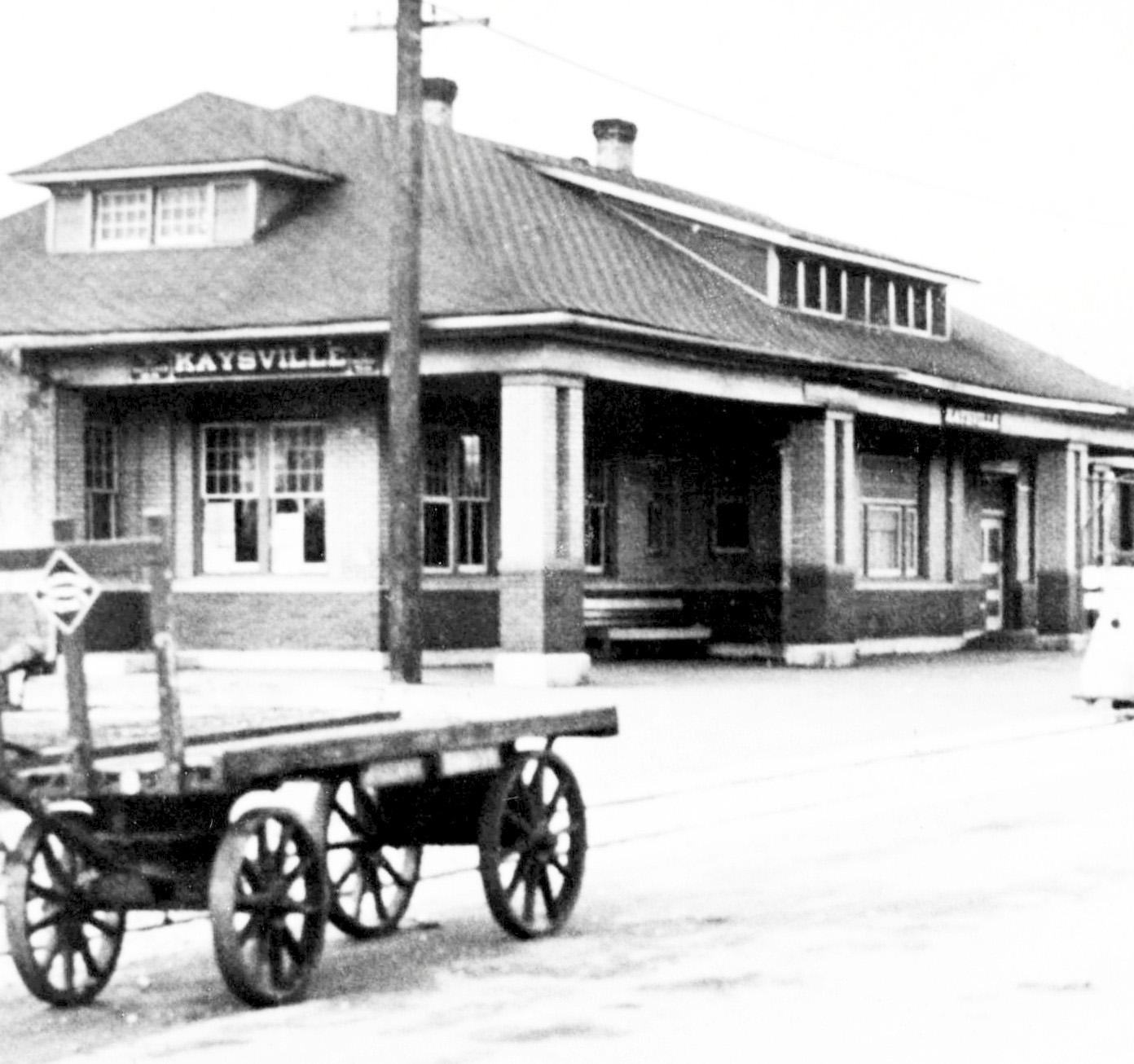
Weekly Reflex Established
The Weekly Reflex was established in Kaysville in 1911. When the founding owner and editor moved to central Utah, a group of Kaysville businessmen bought the paper. William P Epperson and his son, Clyde, had traveled from Green River, Utah, in response to an advertisement for an editor and staff reporter in the spring of 1912. (Sanders)
Davis High School
Davis High School opened its doors in 1914 to students throughout the county. Not until 1953 was another high school built in Bountiful.
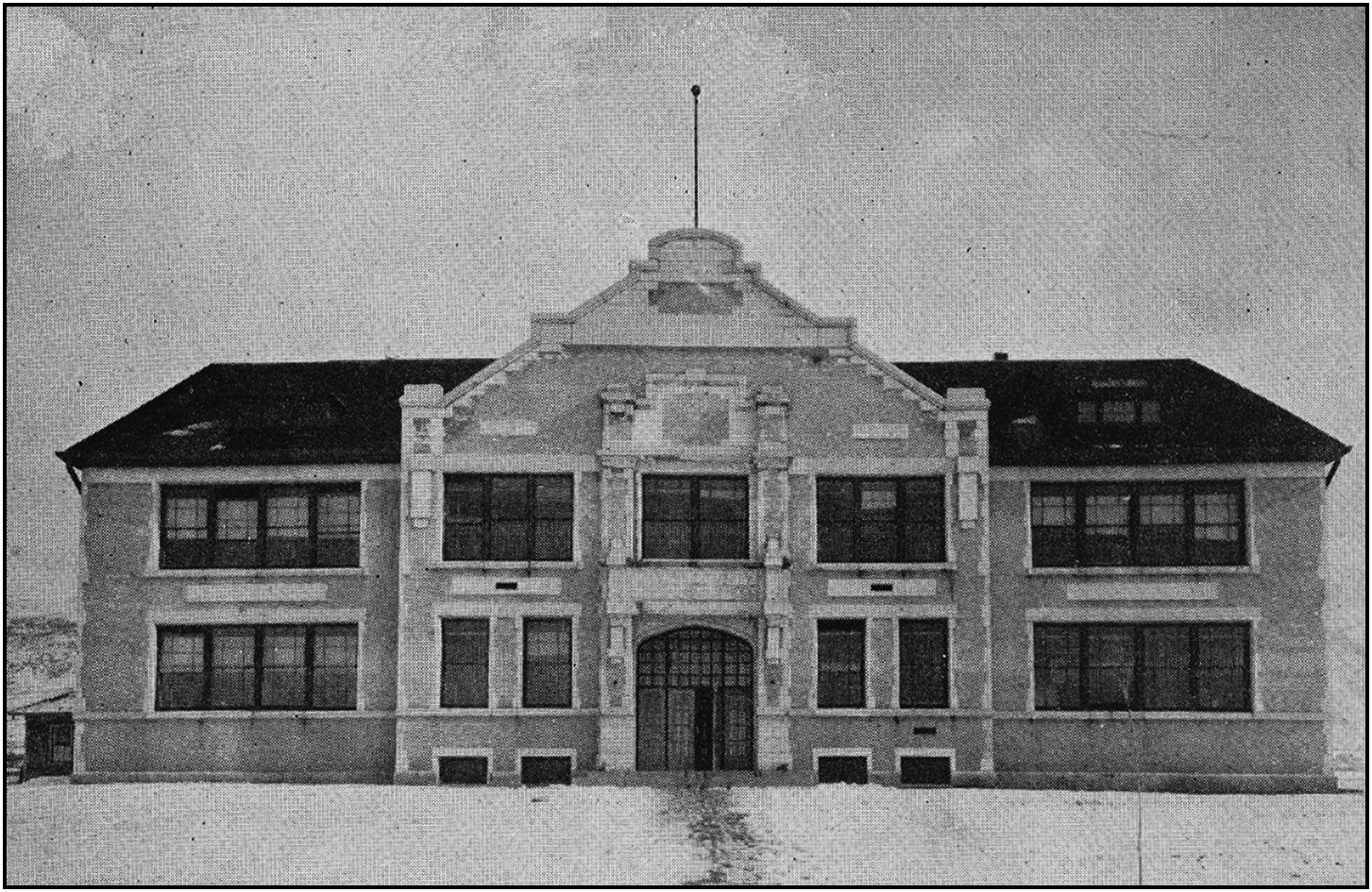
Public Library Open Its Doors
The Kaysville Public library opened its doors in September of 1921, the books donated by T. McClure Peters formed the bulk of the collection. Peters’ law office was located in a room above the Kaysville Co-op Store and Barnes Banking Company on Main Street. (Sanders)
Sources
- Timeline is taken mostly from a slideshow or overhead transparency narration, probably created for the 1996 statehood centennial celebration in Kaysville. It was donated to the KFH Museum in the J. Forest Barker collection. Not titled. Date and author unknown.
- Kay’s Ward: Its Founders and Builders by Bill Sanders. Published by the Kaysville/Layton Historical Society and the Heritage Museum of Layton, Utah. 2008
